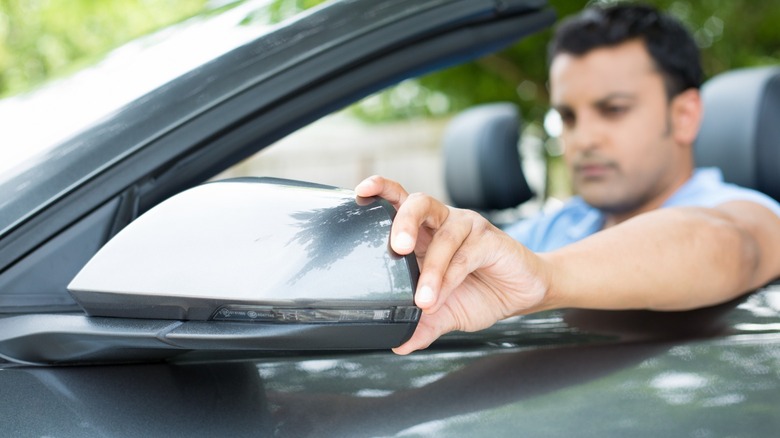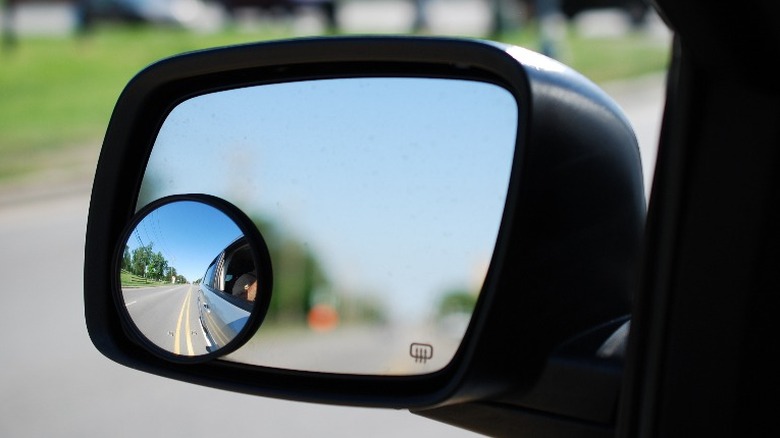How To Minimize The Blind Spots In Your Car
Anyone who has driven long enough understands the dangers of blind spots in a car. Most of us have experienced that sickening, falling-out-of-bed feeling when attempting to change lanes, only to discover that we're inches away from colliding with another motorist. And we've all probably heard the old advice: physically turn your head to check your blind spots and don't rely on your mirrors. Turning your head opens up the possibility for new dangers, though — it only takes a second of distraction to cause a car accident. Anytime you take your eyes off the road ahead, you put yourself and your passengers at risk.
Instead of physically turning your head to check your blind spots, there are a few steps you can follow to minimize the time your eyes aren't on the road and reduce your risk of collision. The best way to do this is to adjust your side-view mirrors properly — most people are guilty of setting up their mirrors incorrectly, and a slight modification can go a long way toward helping drivers minimize blind spots. Additionally, a variety of aftermarket parts are available to help motorists reduce their blind spots, and most of them are relatively inexpensive.
Adjust your side-view mirrors
The best way to minimize the blind spots in your car — at least until cameras replace side mirrors — is to adjust your mirrors correctly. Most people set their side-view mirrors to allow them to see the sides of their own vehicle, but that's actually incorrect. Think about it: your mirrors are in place to help you see other drivers and obstacles on the road, not your own car. Positioning your side-view mirrors in this way prevents you from using them to their full extent and drastically increases the size of your blind spots. Here's the right way to adjust your mirrors:
-
Move your rearview mirror until it gives you a direct view of what's behind you.
-
Lean your head to the left until it lightly touches the driver-side window, then adjust the driver's side-view mirror until you can barely see the side of your own vehicle.
-
Lean toward the center of your car until your head is roughly above the center console, then adjust the passenger side-view mirror until you can barely see the right side of your vehicle.
You may still have minuscule blind spots using this method, but they will be significantly smaller than if your mirrors were adjusted incorrectly. If your mirrors are adjusted properly, you shouldn't have to turn your head away from the road.
Install aftermarket blind spot mirrors
The best way to minimize car blind spots is to adjust your mirrors properly. With that said, you can go one step further by purchasing aftermarket blind spot mirrors to enhance your field of vision while driving. Aftermarket blind spot devices are generally small convex mirrors like the many options available on Amazon. Convex mirrors help minimize blind spots because they provide a wider field of view than standard flat mirrors.
Installing these devices is quick and straightforward. Most use an adhesive to make installation a breeze, but some blind spot mirrors may clip onto the side-view mirror. To install stick-on blind spot mirrors, you'll first need to clean your side-view mirrors to remove any dust, grease, or debris that may prevent the blind spot attachments from sticking. Then, remove the plastic or paper protecting the adhesive and apply the blind spot device to your side-view mirror. Typically, the best position for a blind spot mirror is in the upper outside corner of your side-view mirrors. If you purchase clip-on blind spot mirrors, install the devices by simply clipping them into place on the plastic housing of your side-view mirror.
Even if you choose to purchase aftermarket blind spot mirrors, it's still a good idea to adjust your mirrors properly using the above method. Aftermarket mirrors will provide you with some extra security, but they can't replace safe driving practices as the best way to keep yourself and your passengers secure on the road.


